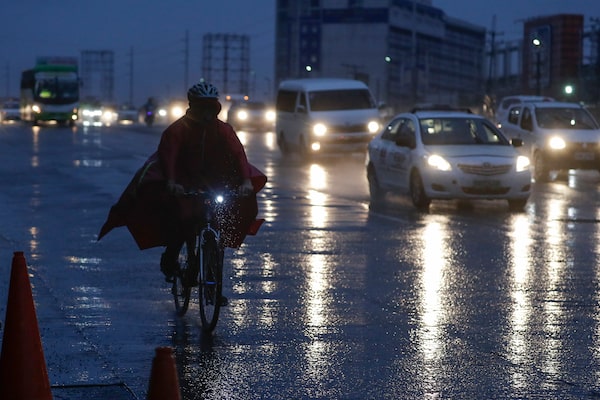
A man rides his bicycle during heavy rains from Typhoon Vamco, in Quezon city, Philippines, on Nov. 11, 2020.Aaron Favila/The Associated Press
A typhoon swelled rivers and flooded low-lying areas as it passed over the storm-battered northeast Philippines, where rescuers were deployed early Thursday to help people flee the rising waters.
The typhoon passed north of Manila between Bulacan and Pampanga provinces, toppling trees and knocking out power. Officials had said previously that nearly 200,000 people had been evacuated, some of them forcibly, from vulnerable coastal and low-lying areas.
Rescue teams were deployed to flooded areas in Rizal province near the capital, Adm. George Ursabia, the coast guard chief, told DZBB radio.
From the Rizal town of Rodriguez, resident Yolanda Laude called the radio station to ask to be rescued. “We’re all on the roof. The water has risen high and reached our second floor. We’ve been here on the roof since 3 a.m., there are six families on our roof,” she told DZBB, which asked for details of her location.
In Pasig city in metropolitan Manila, Carla May Juico and her family went up to the third and last floor of their house as the waters rose during the night. Now, the water has reached the third floor. “We’re thinking of going to the roof. We’ll asked to be rescued,” she told DZBB by phone.
Marikina city Mayor Marcie Teodoro said the fierce winds knocked down power lines overnight, leaving many areas without power and internet connection. Heavy rains also flooded many areas and the Marikina River was swollen.
“There are many areas that historically don’t get flooded but now, they are swamped like the city hall,” he told DZBB radio.
Typhoon Vamco had maximum winds of 130 kilometres per hour with stronger gusts Thursday morning. It was moving west-northwest at 30 kph and would soon leave the main Luzon Island for the South China Sea.
Flooding in 32 villages and a few landslides were already reported Wednesday from the typhoon, and disaster officials said a man died and three other people were missing, without immediately providing details.
The government’s main disaster-response agency had pleaded to the media to relay typhoon alerts in northeastern areas devastated by the earlier Typhoon Goni, saying the agency’s messages could not be sent by cellphones due to damaged telecommunications systems.
Goni, one of the strongest tropical cyclones in the world this year, left more than 30 people dead or missing and damaged or destroyed more than 270,000 houses and shanties, many along coastal villages. Tens of thousands of people remain displaced.
The Philippines is hit by about 20 typhoons and storms each year. It’s also located on the so-called Pacific “Ring of Fire,” where earthquakes and volcanic eruptions are common, making it one of the world’s most disaster-prone countries.
Associated Press journalists Aaron Favila and Joeal Calupitan contributed to this report.
Our Morning Update and Evening Update newsletters are written by Globe editors, giving you a concise summary of the day’s most important headlines. Sign up today.